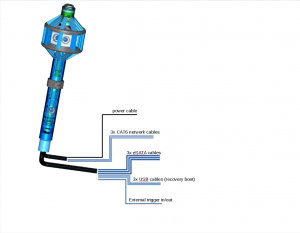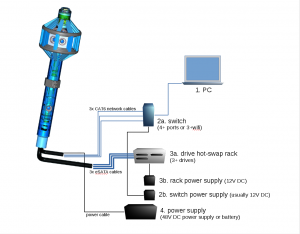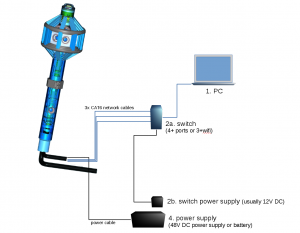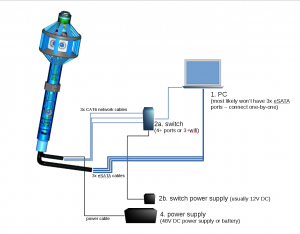Difference between revisions of "Eyesis4Pi 393"
(→Operating) |
|||
| Line 1: | Line 1: | ||
==Status== | ==Status== | ||
| − | ==Overview== | + | Production |
| + | == Overview== | ||
| + | Elphel Eyesis4Pi-393 is the newer generation of the full-sphere multi-camera systems for stereophotogrammetric applications. The camera is [http://blogs.elphel.com/2010/11/zoom-in-now-enhance/ calibrated] to compensate for optical aberrations allowing to preserve full sensor resolution over the camera FoV. [http://blog.elphel.com/2011/10/subpixel-registration-and-distrortion-measurement/ Distortion calibration] is performed for precise pixel-mapping to automatically stitch images into panoramas, and also for [http://en.wikipedia.org/wiki/Photogrammetry photogrammetry]and [http://en.wikipedia.org/wiki/3D_reconstruction_from_multiple_images 3D reconstruction]. <!--due to precise optical calibration of sensor+lens modules and pixel-mapping. Eyesis4Pi can be used for panorama capturing and allow to get high quality final images of the panoramas which no other cameras available on the market can produce. --> | ||
| + | |||
| + | There are 24 x 5MPix sensors in the camera head, resulting in 120 MPix image acquisition. Panorama image resolution after stitching is 64 MPix. | ||
| + | High-precision Inertial Measurement Unit IMU (ADIS 16375, 2400 samples per second) is integrated with the camera, as well as 5Hz GPS (Locosys LS20031) to provide precise position and orientation of the camera. Images, synchronized with IMU and GPS data, are recorded to internal Solid State Drives (SSD) or to an external computer over the network. | ||
| + | Eyesis4Pi camera system includes Eyesis computer for image downloading and post-processing with pre-installed SDK and Free and Open Source Software for camera calibration, image acquisition and panorama stitching. | ||
| + | |||
| + | Eyesis4Pi can be mounted on a car for outdoor panoramic applications or carried by a person, which lets successfully create panoramas of small and narrow spaces.<sup>**</sup><br> | ||
| + | Automated panoramic imagery and 3-dimensional panoramas are 2 main applications of Eyesise4Pi camera. | ||
| + | |||
| + | ==Improvements over older generation [[Eyesis4Pi]]== | ||
| + | * new [[10393]] system boards | ||
| + | ** faster recording | ||
| + | ** more powerful | ||
| + | * more compact - the pole is 2 times shorter | ||
| + | * lighter | ||
==3D Model== | ==3D Model== | ||
Revision as of 19:38, 21 December 2016
Status
Production
Overview
Elphel Eyesis4Pi-393 is the newer generation of the full-sphere multi-camera systems for stereophotogrammetric applications. The camera is calibrated to compensate for optical aberrations allowing to preserve full sensor resolution over the camera FoV. Distortion calibration is performed for precise pixel-mapping to automatically stitch images into panoramas, and also for photogrammetryand 3D reconstruction.
There are 24 x 5MPix sensors in the camera head, resulting in 120 MPix image acquisition. Panorama image resolution after stitching is 64 MPix. High-precision Inertial Measurement Unit IMU (ADIS 16375, 2400 samples per second) is integrated with the camera, as well as 5Hz GPS (Locosys LS20031) to provide precise position and orientation of the camera. Images, synchronized with IMU and GPS data, are recorded to internal Solid State Drives (SSD) or to an external computer over the network. Eyesis4Pi camera system includes Eyesis computer for image downloading and post-processing with pre-installed SDK and Free and Open Source Software for camera calibration, image acquisition and panorama stitching.
Eyesis4Pi can be mounted on a car for outdoor panoramic applications or carried by a person, which lets successfully create panoramas of small and narrow spaces.**
Automated panoramic imagery and 3-dimensional panoramas are 2 main applications of Eyesise4Pi camera.
Improvements over older generation Eyesis4Pi
- new 10393 system boards
- faster recording
- more powerful
- more compact - the pole is 2 times shorter
- lighter
3D Model
|



